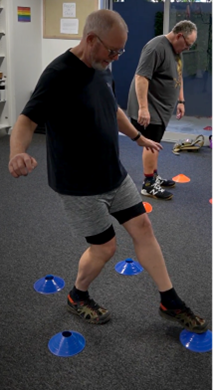A Simple Balance Test
As we get older, our physical function gradually declines, especially when left unattended. We often engage less in physical activity that leads to a reduction in our strength, aerobic fitness and balance. Consequently, we put ourselves at a greater risk of various diseases due to a decline in overall health.
But what can we use to measure our health and in turn predict our mortality?
We know that BMI, aerobic fitness, and blood pressure give us a good idea of our overall health and can all be predictors of all-cause mortality. However, a recent study highlighted that balance might be an equally useful measure.
 The researchers investigated a balance test called the 10-second one-leg stand test (10s OLS test) and whether it could predict mortality in middle-aged and older adults. (Araujo et al., 2022). The study had a large number of participants, with ages ranging from 51-75 and an average age of 62. The 10s OLS test was performed on either their left or right foot, in barefoot, with the other leg tucked behind their calf. Up to 3 attempts were allowed, and individuals were classified as Yes, able to hold for >10s or no, or unable to hold for 10s.
The researchers investigated a balance test called the 10-second one-leg stand test (10s OLS test) and whether it could predict mortality in middle-aged and older adults. (Araujo et al., 2022). The study had a large number of participants, with ages ranging from 51-75 and an average age of 62. The 10s OLS test was performed on either their left or right foot, in barefoot, with the other leg tucked behind their calf. Up to 3 attempts were allowed, and individuals were classified as Yes, able to hold for >10s or no, or unable to hold for 10s.
The initial results showed that 20% of people failed to stand on either leg for more than 10 seconds, with reduced ability to pass the test as age increases. This is displayed in the table below.

The researchers followed up with the participants 12 years later and analysed the results to see whether this test could predict mortality. A total of 123 (7.2%) people passed away, with the majority of those people in the group that was not able to pass the test.
Their analysis showed that if you were unable to pass this test, then you had a lower lifespan of 7 years and an 84% chance increase of overall mortality.
Does this mean that increasing my balance will let me live longer?
While the authors reported that good levels of balance are necessary for our everyday lives, improving balance after test results will not necessarily reduce mortality risk.
However, reducing the risk of falls can have a massive impact on longevity. In Australia, falls result in 224,000 hospitalisations and 5,300 deaths each year, with the majority of these occurring in older people in their own homes (AIHW, 2021). Falls can result in fractures, open wound injuries and even brain damage.
Therefore, reducing the incidence of falls can prevent many injuries and save lives!
How can we improve our balance?
 We know that exercise training, specifically a combination of
We know that exercise training, specifically a combination of
strengthening and balance exercises is the most effective way to help
reduce falls in individuals (Thomas et al., 2019). Aerobic exercise,
such as going for a 30-minute walk, has also been shown to reduce falls
risk in middle aged and elderly adults (Shubert, 2011).
An important part of the research showed that those who did not engage in any type of exercise training, saw a decline in their balance and increase in risk of falls (Thomas et al., 2019).
So, whether choosing to specifically work on your balance, or take the dog
for a walk around the block, some form of exercise is better than none to
help reduce our falls risk.
To sum this topic up, while improving our 10s OLS test may not necessarily reduce our mortality risk, improving our balance through some form of exercise training will help reduce our risk of falls, and allow us to live happier and healthier lives.


